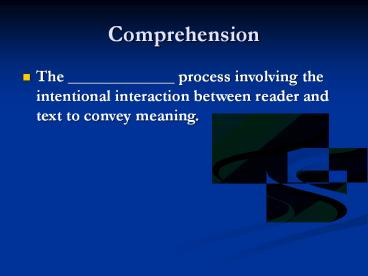Comprehension - PowerPoint PPT Presentation
Title:
Comprehension
Description:
Comprehension The _____ process involving the intentional interaction between reader and text to convey meaning. Comprehension is... The _____ of reading ... – PowerPoint PPT presentation
Number of Views:47
Avg rating:3.0/5.0
Title: Comprehension
1
Comprehension
- The _____________ process involving the
intentional interaction between reader and text
to convey meaning.
2
Comprehension is...
- The ____________ of reading
- The content of meaning is influenced by the text
and by the contribution of the reader's
______________ (Anderson Pearson, 1984).
3
Specific Comprehension Skills for the Early
Primary Level
- Three early primary-grade comprehension skills
- Literal Comprehension
- _____________
- Summarization
4
Literal Comprehension
- Involves teaching students to retrieve
information stated in a passage - Simplest written comprehension exercise
- What is the difference between literal and
nonliteral comprehension items? - Format p. 222
5
Sequencing
- Requires ordering several events according to
when they occur in a passage - e.g., A student reads a passage and then writes
numbers in front of several phrases that describe
events, writing 1 in front of the event that
occurred first, 2 in front of the event that
occurred next, etc. - Text p. 225
6
Summarization
- Not only allows students to identify key ideas,
but ______________________________________________
_______________________ - Summary condenses a passage into a few sentences
- One-sentence summary can be considered a main
idea
7
Summarization Teaching Procedure
- Teacher tells students a rule for writing a main
idea sentence (e.g., Name the person and tell the
main thing the person did in all the sentences) - Students read the passage
- Teacher asks the students to figure out a main
idea sentence by naming the person and telling
what the person did in all the sentences
8
- Teacher calls on a student to say the sentences
(teacher corrects the student by telling the
correct answer) - Teacher repeats the same procedure with the
remaining passage - Teacher has the students write the main idea
sentence for each paragraph (difficult to spell
words would be written on the board)
9
Commercial Basal Reading Programs
- Mainly include narrative reading passages
- Stories have text structure called story grammar
- Structure revolves around conflicts or problems
faced by characters in the story and their
attempts to resolve the problem - Components of story grammar
- Conflict
- Goal
- Resolution of conflict
- Plot
- The characters thoughts and feelings are common
to many stories
10
Procedures for presenting components of story
grammar
- Progress from simple stories to more complex
stories - Factors to consider
- Number of characters, plots, goals
- Number of attempts by characters to achieve goals
- Explicitness of story grammar components (main
character, goals, conflict) - Length of the story
- Readability of story (structure of sentences)
- Amount of background knowledge required of
students
11
Advanced Story-Reading Comprehension
- Two procedures to teach advanced story
comprehension - A ___________________ designed to help students
summarize and clarify story grammar components
during reading (p. 256) - A _______________ in which the teacher summarizes
and points out how to anticipate questions to be
asked.
12
Intermediate Grades
- Major emphasis shifts from learning to read to
reading to learn - Children begin reading _______________materials
- Content-area textbooks or reference books
designed to convey factual information or to
explain what is difficult to understand
13
Why is comprehension of expository material
difficult?
- Very different from narrative material
- New ______________ and use of typographic
features and graphics - ______________ is difficult to understand and
introduced at a high rate - Ease in understanding comes from prior knowledge
that allows the student to build on previously
introduced concepts
14
- In narrative writing, students were carried
through the material - In expository writing, there is no build up to
the critical point - Instead, many equally important concepts are
introduced - It may not be at an appropriate reading level for
your students.
15
Four parts of content-area lesson
- ________________
- ________________
- ________________
- _________________
16
Preparation
- Read the material several times
- Select ________________
- Develop ______________
- Rather than overviewing everything, identify the
critical information and commit to teaching it.
These are the main ideas. - Design (or adapt) a Chapter Test
- Must match the critical content
- Link between objectives and test items
- Describe, identify, explain
- Divide the chapter into _____________________
17
Prereading
- Teach Difficult-to-Decode Words
- Focus on phonic and structural analysis
- Forest, renewable
- Teach _____________________
- DI procedures
- Concept map (graphic organizers) visual
representation p. 271 - Feature Analysis
- Concepts fall in 1 category (p. 287) have
features or does not have features - Preview ________________
- Preview selection (title, headings, summary,
questions at end)
18
Reading
- ________________
- 1. Guiding quest ion Read to find out
- 2. Read silently then orally
- 3. Teacher asks questions
- ____________________
- 4 strategies question generating, summarizing,
clarifying, predicting - __________________
- Coach reader, correction procedures, paragraph
shrinking - ________________
- Verbal rehearsal (SQ3R written rehearsal (note
taking)
19
Postreading Activities
- ______________
- p.302
- Major concepts
- Literal and inferential
- Beyond yes and no responses
- Well worded to promote ease of interpretation
- ______________________
- 1. skim 2. list key points 3. combine related
points into signal statements 4. cross out least
important 5. reread 6. combine and cross out to
condense points 7. number remaining points in
logical order 8. write points into paragraph in
numbered order - __________________________
20
National Center on Accessing the General
Curriculum
- http//www.cast.org/publications/ncac/ncac_go.html
- Other valuable websites
- http//www.eduplace.com/graphicorganizer/
- http//www.thinkingmaps.com/































